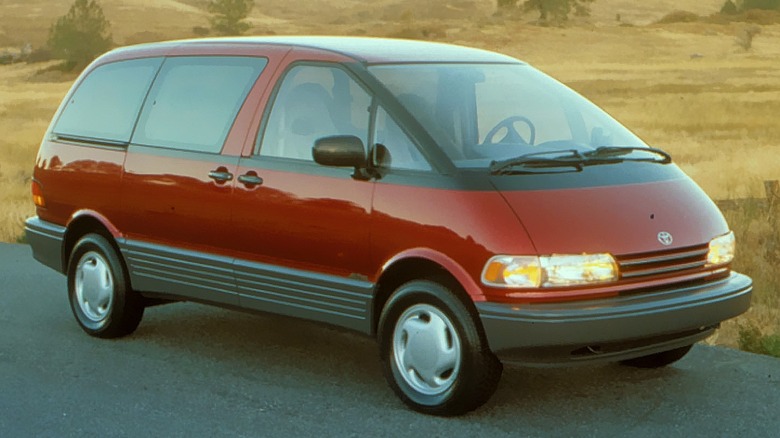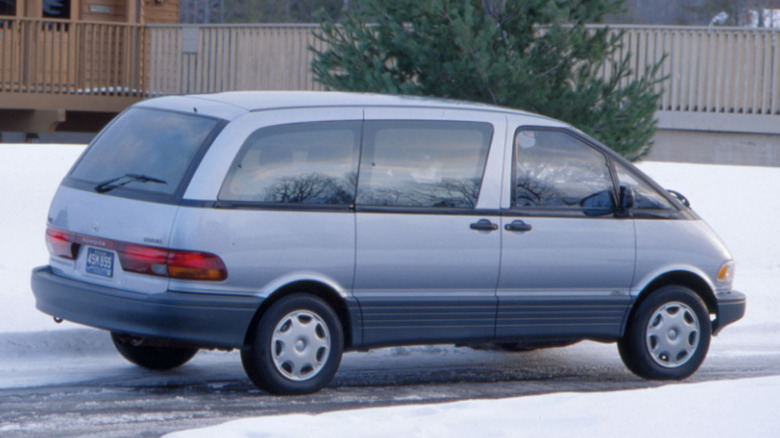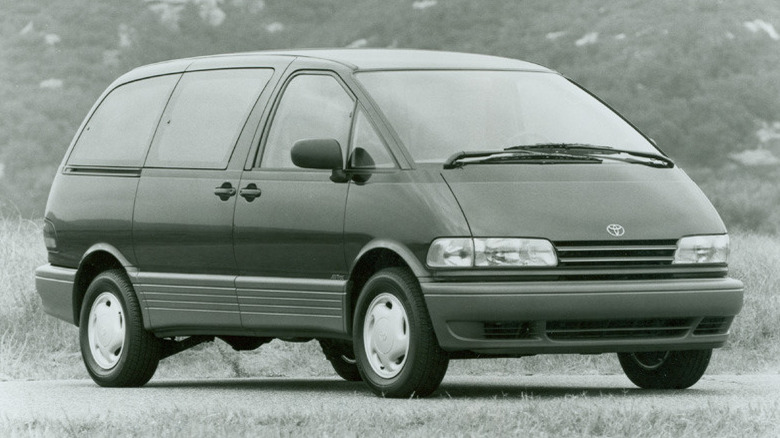Here's Why The Toyota Previa Was Way Cooler Than You Think
Minivans have always been cool to a certain subset of automotive culture, but to the average "Fast and Furious" fan or connoisseur of American muscle and JDM cars, minivans are still unfortunately synonymous with boring suburban mundanity even more so than any number of crossovers and SUVs. Minivans, to many, are unexciting and a convenient scapegoat for everything one may perceive as wrong about cars. But that is an unfortunate misrepresentation at best, and worst, flat-out wrong. The Toyota Previa is a perfect example.
On the outside, the Previa looks like an egg from space and the front looks very similar to the back. And yet the stylish design, if one could call it that, betrays the fact that the humble Previa minivan is more mechanically similar to a supercar, at least in layout, than just about any other minivan that came before or after.
The Previa is a mid-engine rear-wheel drive car, making it closer to a C8 Corvette than a Toyota Sienna or Honda Odyssey. Most minivans (with the exception of the Chevy Astro/GMC Safari and a scant few others) have the engine in the front, which is connected to a transaxle that drives the front wheels. In a Previa, the driver is literally sitting on top of the engine. The hood is a small access panel directly under the driver's seat. That cutout in the floor allows the owner to access spark plugs and work on the car. But what was the advantage of the Previa's midengine layout?
Comfortable and spacious
It certainly wasn't the engine specifications that gave the Previa its cool factor. The four-cylinder engine produced only 138 horsepower, which is more than adequate for hauls to Disney World over the summer, but hardly a performance monster. The Previa's whale shark-like shape allowed it to swallow all sorts of cargo or up to seven passengers. But that's not really unusual for any number of minivans, although reviews from 1990, the first year the Previa was offered, noted that the interior was notably more spacious and comfortable than competing vans of the miniature variety. Moving the engine essentially underneath of the car allowed the interior to have more usable space within the wheelbase.
Just by the nature of the vehicle, front-engined cars can handle differently than mid-engine cars. The heaviest part of the car's drivetrain, the engine, can have a notable impact on how the car behaves when you're sawing the steering wheel. Midengine vehicles tend to have a more centered weight distribution, leading to more predictable handling.
Normally minivans spend their entire lives getting filled with all manner of crumbs and gummy worms until they graduate to carrying furniture or the odd mountain bike. They aren't designed to traipse around a racetrack with all the grace of a hand-built supercar that costs as much as a city block. According to a Car and Driver review from the era, the Previa handled twisty back roads and the highway equally well and it was downright easy and comfortable to drive. Placing the engine directly under the driver wasn't a mere party trick.
Available with a supercharger
If the midengine placement wasn't strange or cool enough, later models of the Previa were available with a supercharger. Yes, the same technology that gives the Dodge Challenger SRT Hellcat its hellacious power. Normally, superchargers are bolted to the top of the engine. But, as you've probably guessed by now, the Previa doesn't have a normal supercharger. Instead of power delivery via a belt connected directly to the engine's crankshaft, the Previa's supercharger was not bolted to the engine at all and spooled up via a belt connected to a driveshaft coming from the engine.
Functionally, it worked the same as other supercharged cars, but mechanically, it was more of a long-distance supercharger, rather than an in-house operation. The supercharger helped the Previa achieve 161 horsepower and 204 lb-ft of torque, about the same for a particularly torquey V6 from the era — the Toyota just did things a lot differently. The Previa might be one of the strangest vehicles to ever come from Toyota, the maker of the Camry, the automotive equivalent of a multivitamin.


